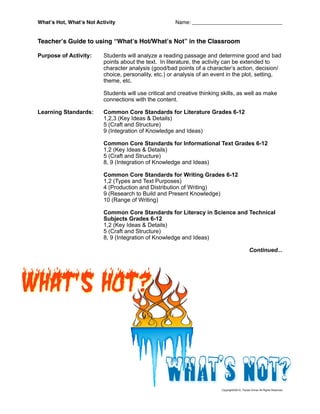
Hot not activity
- 1. Whatʼs Hot, Whatʼs Not Activity ! Name: _______________________________ Teacherʼs Guide to using “Whatʼs Hot/Whatʼs Not” in the Classroom Purpose of Activity: Students will analyze a reading passage and determine good and bad points about the text. In literature, the activity can be extended to character analysis (good/bad points of a character’s action, decision/ choice, personality, etc.) or analysis of an event in the plot, setting, theme, etc. Students will use critical and creative thinking skills, as well as make connections with the content. Learning Standards: Common Core Standards for Literature Grades 6-12 1,2,3 (Key Ideas & Details) 5 (Craft and Structure) 9 (Integration of Knowledge and Ideas) Common Core Standards for Informational Text Grades 6-12 1,2 (Key Ideas & Details) 5 (Craft and Structure) 8, 9 (Integration of Knowledge and Ideas) Common Core Standards for Writing Grades 6-12 1,2 (Types and Text Purposes) 4 (Production and Distribution of Writing) 9 (Research to Build and Present Knowledge) 10 (Range of Writing) Common Core Standards for Literacy in Science and Technical Subjects Grades 6-12 1,2 (Key Ideas & Details) 5 (Craft and Structure) 8, 9 (Integration of Knowledge and Ideas) Continued... What’s Hot? What’s Not? Copyright©2010, Tracee Orman All Rights Reserved
- 2. Whatʼs Hot, Whatʼs Not Activity ! Name: _______________________________ Teacher’s Guide, continued... Directions: 1. After reading a passage (a chapter, an essay or speech, short story, poem, etc.), ask the students to choose specifics in the content that would be considered: a. “hot” (meaning “cool”--I know, it’s a paradox--or good, positive, fun, etc.) b. “not” (meaning uncool, bad, negative, etc.) 2. Language Arts/History: Students should analyze the passage by asking questions, such as: -What caused ______ to happen? -What was the motivation behind this event? -Why did this person/character make that decision? -What do others like about this person/character? -What do others dislike about this person/character? -Why was this a good choice? Why a bad choice? -How will others view this decision or event? Or Character/person? Science/Math: Students should analyze the material by asking questions, such as: -If this concept/formula/element could speak, what would it say? -How has this concept/formula/element contributed to society/the world? -How do others view this concept/formula/element? -How can it be utilized in life? *This activity really forces students in math and science to think creatively, which is a great skill to practice in any content. 3. Students should record their findings on the handout or a separate sheet of paper. They could also use poster board and work as a group and present it to the class. Lesson Extensions: 1. Presentation: Have students create a presentation and use it as a mini-speech. (Could be as groups or partners.) 2. Faculty Activity: Use the Hot/Not form for creating funny stress-relievers to post in the faculty lounge. Example: What’s Hot: Three hours of silence while students took their standardized test! What’s Not: Seven months of complaining, whining, and grading of practice exams. 3. Journalism/Newspaper/Yearbook: Feature it as a regular column in the newspaper or in the yearbook to record the cool and not-so-cool things that happened throughout the year. 4. Ice-Breaker or End-of-the-Term Activity: Have students write their favorite/not-so-favorite things about the summer, about the class, the unit, etc. 5. Video Assessment: Instead of a reading passage, use it after watching a video. Could be used in place of a quiz over how well they paid attention, or as an assessment of whether they grasped the main concepts or not. Check out my other lessons & activities: http://www.teacherspayteachers.com/Store/Tracee-Orman My Blog: http://hungergameslessons.blogspot.com/ Copyright©2010, Tracee Orman All Rights Reserved
- 3. Whatʼs Hot, Whatʼs Not Activity ! Name: _______________________________ What’s Hot? What’s Not? Copyright©2010, Tracee Orman All Rights Reserved
- 4. Whatʼs Hot, Whatʼs Not Activity ! Name: _______________________________ What’s Hot? What’s Not? Copyright©2010, Tracee Orman All Rights Reserved
- 5. Whatʼs Hot, Whatʼs Not Activity ! Name: _______________________________ What’s Hot? What’s Not? Copyright©2010, Tracee Orman All Rights Reserved
